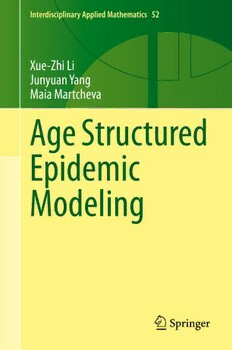Table Of ContentInterdisciplinary Applied Mathematics 52
Xue-Zhi Li
Junyuan Yang
Maia Martcheva
Age Structured
Epidemic
Modeling
Interdisciplinary Applied Mathematics
Volume 52
Editors
AnthonyBloch,UniversityofMichigan,AnnArbor,MI,USA
CharlesL.Epstein,UniversityofPennsylvania,Philadelphia,PA,USA
AlainGoriely,UniversityofOxford,Oxford,UK
LeslieGreengard,NewYorkUniversity,NewYork,USA
Advisors
L.Glass,McGillUniversity,Montreal,QC,Canada
R.Kohn,NewYorkUniversity,NewYork,NY,USA
P.S.Krishnaprasad,UniversityofMaryland,CollegePark,MD,USA
AndrewFowler,UniversityofOxford,Oxford,UK
C.Peskin,NewYorkUniversity,NewYork,NY,USA
S.S.Sastry,UniversityofCaliforniaBerkeley,CA,USA
J.Sneyd,UniversityofAuckland,Auckland,NewZealand
RickDurrett,DukeUniversity,Durham,NC,USA
Moreinformationaboutthisseriesathttp://www.springer.com/series/1390
Xue-Zhi Li • Junyuan Yang (cid:129) Maia Martcheva
Age Structured Epidemic
Modeling
Xue-ZhiLi JunyuanYang
CollegeofMathematics ComplexSystemsResearchCenter
andInformationSciences ShanxiUniversity
HenanNormalUniversity Taiyuan,Shanxi,China
Xinxiang,Xinxiang,China
MaiaMartcheva
DeptofMath,LittleHall358
UniversityofFlorida
Gainesville,FL,USA
ISSN0939-6047 ISSN2196-9973 (electronic)
InterdisciplinaryAppliedMathematics
ISBN978-3-030-42495-4 ISBN978-3-030-42496-1 (eBook)
https://doi.org/10.1007/978-3-030-42496-1
Mathematics Subject Classification (2010): 34D05, 34D20, 34D23, 34D45, 34F10, 35A09, 35B09,
35B10,35B30,35D30,35B32,35B40,35D35,35E15,37C10,37C75,37G15,45A05,45D05,45E10,
45J05,45P05,46E15,46E30,47A10,47A11,47A75,47B07,47B33,47B34,47B38,47H05,47H09,
47H10,49K40,49G50,62P10,62P25,65F50,65L11,65R10,74G30,74G35,91A05,91A22,92B05,
92D25,92D30,93C20,93D20,93C15
©SpringerNatureSwitzerlandAG2020
Thisworkissubjecttocopyright.AllrightsarereservedbythePublisher,whetherthewholeorpartof
thematerialisconcerned,specificallytherightsoftranslation,reprinting,reuseofillustrations,recitation,
broadcasting,reproductiononmicrofilmsorinanyotherphysicalway,andtransmissionorinformation
storageandretrieval,electronicadaptation,computersoftware,orbysimilarordissimilarmethodology
nowknownorhereafterdeveloped.
Theuseofgeneraldescriptivenames,registerednames,trademarks,servicemarks,etc.inthispublication
doesnotimply,evenintheabsenceofaspecificstatement,thatsuchnamesareexemptfromtherelevant
protectivelawsandregulationsandthereforefreeforgeneraluse.
Thepublisher,theauthors,andtheeditorsaresafetoassumethattheadviceandinformationinthisbook
arebelievedtobetrueandaccurateatthedateofpublication.Neitherthepublishernortheauthorsor
theeditorsgiveawarranty,expressedorimplied,withrespecttothematerialcontainedhereinorforany
errorsoromissionsthatmayhavebeenmade.Thepublisherremainsneutralwithregardtojurisdictional
claimsinpublishedmapsandinstitutionalaffiliations.
ThisSpringerimprintispublishedbytheregisteredcompanySpringerNatureSwitzerlandAG.
Theregisteredcompanyaddressis:Gewerbestrasse11,6330Cham,Switzerland
Preface
Age-structuredepidemicmodelsdatebacktotheearlytwentiethcenturywhenKer-
mackandMcKendrickcreatedtheirwell-knownSIRmodeltoexplaindiseaseout-
breakssuchastheplagueorcholera.EvenoneoftheoriginalKermack-McKendrick
modelsis,infact,discreteage-since-infectionstructuredtocapturebetterthepoten-
tial changes in infectivity and recovery, depending on time-since-infection. Since
KermackandMcKendrick,age-structuredepidemicmodelshavehadasteadypres-
ence among the infectious disease literature. Their major contribution to mathe-
matics was a novel type of partial differential equations with nonlocal boundary
conditions,whoseanalysishaschallengedmathematiciansinthelast70years.The
mathematicalsetupforthesefirstorderPDEsiscompletelydifferentthanthe“tradi-
tionalsecondorderPDEs”—itrequiresworkinginL1 spaceswhicharenotHilbert
spacesandarenotreflexive.
Interestinage-structuredmodelswasrenewedatthebeginningofthetwenty-first
centurywiththeappearanceofseveraltypesofmulti-scaleimmuno-epidemiological
models.Allthesenewlydevelopedmodels,someofwhichmaybecomeastandard
of modeling in infectious diseases, will continue challenging mathematicians for
yearstocome.
Therearealotofveryniceintroductionbookstoage-structuredmodeling.Some
oftheminvolvetheeditedbook“MathematicalEpidemiology”(Springer),thetext-
book “Introduction to Mathematical Epidemiology” by M. Martcheva (Springer,
2015), the “Mathematical Models in Population Biology and Epidemiology” by
F. Brauer and C. Castillo-Chavez (Springer, 2002), “The Basic Approach to Age-
Structured Population Dynamics” by M. Iannelli and F. Milner (Springer, 2017),
and others. The present book is not meant as an introduction to age-structured
modeling—it is meant as a tool to develop the skills of graduate students and re-
searcherswhowishtomakeage-structuredepidemicmodelingtheirareaofexper-
tise.Themathematicaltoolsthatcurrentlyserveage-structuredepidemicmodeling
arepresentedinthebookthroughexamples.Manyofthesetoolsalreadyexistinthe
literature—publishedinpapers.However,thebookdemonstratesthemondifferent
examplesandataslowerpace,withmoreexplanationscomparedtoregulararticles.
The presentation of the tools in the book is also graded in difficulty, from regu-
v
vi Preface
lar functional-analytic tools to C -semigroup tools to integrated semigroup tools.
0
The only other book that the authors know of that comes this close in developing
the mathematical tools is a recent book by H. Inaba “Age-Structured Population
DynamicsinDemographyandEpidemiology”(Springer,2017).Ourgoalwiththe
bookisthatthisbookservestotrainawholenewgenerationofmathematicalepi-
demiologists, ready to tackle the analytical and numerical challenges of the novel
age-structuredpopulationandepidemicmodeling.
The book starts with an introduction to chronological age-structured popula-
tionmodelswhichisonlymeanttopreparethereadertotacklechronologicalage-
structuredepidemicmodels,whicharediscussedinChap.2.Alongwiththemodels,
we introduce here a general theorem for proving well posedness of age-structured
models,wediscuss,basicanalysis,someearlytoolsfordetecting backward bifur-
cationinage-structuredmodelsaswellassettingupandsimulatingoptimalcontrol
problems. All these techniques are routinely used with ODE epidemic models but
are rarely in the arsenal of mathematical epidemiologists when it comes to age-
structuredmodeling.Chapter3focusesonimmuno-epidemiologicalmodeling.We
believe that age-structured population modeling, analysis, and simulations will be
drivenintheyearstocomeprimarilybydevelopmentsinimmuno-epidemiological
or multi-scale modeling. Chapter 3 describes some well-known and some novel
(bidirectionallylinked)immuno-epidemiologicalmodelsaswellassomeoftheex-
isting analysis tools but much of the tools necessary for the analysis and simula-
tionofthesetypesofmodelsarestillyettocome.Someoftheopenquestionshere
are:Howdowefindoscillationsinunidirectionallylinkedimmuno-epidemiological
models,ifthetoolsdevelopedforregularage-since-infectionmodelsdonotapply
here? How do we analyze bidirectionally linked immuno-epidemiological models
giventhattheircomplexityishigherandpresentschallengestoexistingtools?Chap-
ter4introducesage-since-infectionstructuredepidemicmodelscoupledwithgame
theory.Gametheoryhasbeenusedtoanalyzebehavioralimplicationsoninfectious
diseaseepidemiology.Itisoftenusedtostudythedecisionspeoplemaketocomply
(or not to comply) with some control strategies, such as vaccination. Most of the
modelsinthisdirectionareODEmodels.Inthischapter,weintroduceanumberof
age-since-infectionstructuredPDEmodelstogetherwiththeappropriatefunctional-
analytictoolsfortheiranalysis.Chapter5discussesnetworkage-structuredmodels.
Complexnetworksarethestandardofmodelingofcomplexsystemsbutthemod-
elsaretypicallysimulationalanddonotlendthemselvestoclosed-formequations
thatcanbeanalyzed.Herewepresent,undersomeassumptions,closed-formage-
structured epidemic models built on complex, typically scale-free, networks. We
developfunctional-analytictoolsfortheiranalysis.Chapter6introducesanumber
ofchronologicalageandage-since-infectionstructuredmodelsofvector-bornedis-
eases.Althoughmodelslikethesecanbefoundreadilyintheliterature,weusethem
asexamplestoillustrateanumberoffunctional-analytictechniques,aswellastech-
niquesbasedonC -semigrouptheory.C -semigroupsareanalyticaltoolsthathave
0 0
had long existence but have been applied to age-structured epidemic models only
sincethelatetwentiethcentury.OneniceintroductorytextbooktoC -semigroupsis
0
theonebyA.Pazy“SemigroupsofLinearOperatorsandApplicationstoPartialDif-
Preface vii
ferentialEquations”(Springer,1983)andamorerecentreferencebyK.Engeland
R. Nagel “One-Parameter Semigroups for Linear Evolution Equations” (Springer,
2000).C -semigroups arefurtherusedasthemaintoolofanalysis alsoinChap.7
0
whichintroducesandtacklesmetapopulationepidemicmodelsandmulti-groupepi-
demic models with chronological age.C -semigroups are a powerful tool to study
0
age-structuredmodelsbuttheyoftenfallshortintheanalysisofage-since-infection
or other class-age structured models. The main reason is that class-age structured
models often have as a boundary condition of the PDE a term that depends in a
nonlinear way on the dependent variables. That, in general, precludes the use of
C semigroups,unlessanappropriatechangeofvariablesismadetotransformthe
0
problemintoonewithazeroboundarycondition.Sincethischangeofvariablesis
nonobviousorimpossibletomake,thistypeofproblemsarebesttreatedbytheso-
called integrated semigroups or semigroups with non-densely defined generators.
ThebestintroductionheremaybeanarticlebyH.Thieme“IntegratedSemigroups
and Integrated Solutions to Abstract Cauchy Problems” in JMAA, 1990. We use
integratedsemigroupstoanalyzeanumberofexampleclass-agemodelsinChap.8.
Weincludesomefrequentlyusedmathematicaltoolsintheappendix.
Thisbookemergedfromthelong-termfriendshipofitsauthorsanditisaresult
ofcollaborationofscientistsfromacrosstheworld,oftensupportedandencouraged
by the National Funding Agencies. The authors would like to thank the National
ScienceFoundationoftheUSAandtheNationalScienceFoundationofChinafor
bringingthemtogether.Further,theauthors thankthewarmhospitalityofUniver-
sityofFloridathatmadetheirfacecollaborationonthebookpossible.Theauthors
would like to thank their Springer editors Donna Chernyak and Danielle Walker
who believed in the book and encouraged them to work. The authors also thank
theirfamiliesfortheirpatiencewhiletheauthorswereworkingonthebook.
Webelievethatthisbookisuniqueinthesensethatitisperhapsthefirstattempt
tomergethebestofthemathematicseducationandtraininginAsia,NorthAmerica,
and Europe. The differences in these educational systems made the writing of the
booksomewhatchallenging.Wehopewehaverisentothechallengeandthebook
that has emerged will contribute seriously to the training of the next generation
expertsinage-structuredpopulationandepidemicmodeling.
Xinxiang,China Xue-ZhiLi
Taiyuan,China JunyuanYang
Gainesville,FL,USA MaiaMartcheva
Contents
1 Linear Age-Structured Population Models as a Base of
Age-StructuredEpidemicModels ................................ 1
1.1 TheLotka-McKendrick-vonFoersterModel .................... 1
1.1.1 TheMcKendrickAge-StructuredPDEModel ............ 1
1.1.2 TheLotkaIntegralEquationModel ..................... 3
1.2 PropertiesoftheSolutionsofLotka-McKendrickModel.......... 4
1.2.1 Existence and Uniqueness of Solutions
oftheLotka-McKendrickModel ....................... 5
1.2.2 Long-TermBehavior ................................. 6
1.2.3 PersistentSolutionsoftheLotka-McKendrickModel ...... 8
1.2.4 TheSharpe-LotkaTheorem............................ 9
1.3 CombiningtheAge-StructuredPopulationwithEpidemicModels.. 10
1.3.1 HomogeneousAge-StructuredEpidemicModels.......... 12
1.3.2 Age-StructuredEpidemicModelswithStationaryPopulation 15
1.3.3 Age-StructuredModelswithDisease-InducedMortality.... 16
1.3.4 Age-StructuredEpidemicModelswithConstantTotal
BirthRate .......................................... 18
1.4 EarlyAge-StructuredEpidemicModels........................ 19
2 Age-StructuredEpidemicModels ................................ 23
2.1 AnalysisofAge-StructuredEpidemicModels................... 23
2.1.1 WellPosednessofAge-StructuredEpidemicModels ...... 23
2.1.2 ComputingR forAge-StructuredEpidemicModels ...... 27
0
2.1.3 BackwardBifurcationinAge-StructuredModels.......... 30
2.2 AnAge-StructuredSIRModelwithReinfection................. 32
2.2.1 BasicAnalysisoftheSIRModelwithReinfection ........ 33
2.2.2 StabilityoftheDisease-FreeEquilibrium ................ 38
2.3 NumericalMethodsforAge-StructuredEpidemicModels......... 40
2.4 OptimalControlofAge-StructuredModels..................... 42
2.4.1 TheOptimalControlProblem.......................... 43
ix
x Contents
2.4.2 DerivingtheAdjointSystemandtheCharacterization
oftheControl ....................................... 44
2.4.3 NumericalMethods .................................. 48
2.4.4 NumericalSimulations ............................... 50
2.5 Two-StrainAge-StructuredEpidemicModels ................... 53
2.5.1 Disease-FreeEquilibriumandReproductionNumbers ..... 54
2.5.2 StrainOneandStrainTwoEquilibriaandInvasionNumbers 58
Appendix ...................................................... 60
3 NestedImmuno-EpidemiologicalModels ......................... 69
3.1 NestedImmuno-EpidemiologicalModeling .................... 69
3.1.1 Within-HostModels.................................. 69
3.1.2 ComposingImmuno-EpidemiologicalModels ............ 72
3.1.3 An Immuno-Epidemiological Model of Disease
withRecovery....................................... 74
3.2 AnalysisofImmuno-EpidemiologicalModels................... 76
3.2.1 AnalysisoftheSIRImmuno-EpidemiologicalModel ...... 77
3.2.2 StabilityoftheSIImmuno-EpidemiologicalModelofHIV . 80
3.2.3 ImpactofWithin-HostParametersontheBetween-Host
Dynamics .......................................... 83
3.3 BidirectionallyLinkedImmuno-EpidemiologicalModels ......... 84
3.3.1 ABidirectionallyLinkedModelofHIV ................. 85
3.3.2 BidirectionallyLinkedImmuno-EpidemiologicalModel
ofCholera .......................................... 89
3.4 Immuno-EpidemiologicalMulti-StrainModels.................. 94
3.4.1 An n-Strain Immuno-Epidemiological Competitive
ExclusionModel..................................... 95
3.4.2 ATwoStrainModelStructuredbyInoculumFraction ..... 96
3.4.3 Multi-Strain Models with Trade-Off Mechanisms
ontheBetween-HostScale ............................ 99
4 Age-Since-InfectionStructuredModelsBasedonGameTheory .....105
4.1 Introduction ...............................................105
4.2 Imitation Dynamics of Vaccine Decision-Making Behaviors
BasedontheGameTheory ..................................109
4.2.1 ExistenceofEquilibriaandTheirLocalStability..........115
4.2.2 The Attractivity of Boundary Equilibria and Disease
Persistence..........................................124
4.2.3 NumericalSimulations ...............................131
4.2.4 Discussion..........................................133
4.3 ImitationDynamicsintheCaseofVaccinatingSusceptibles.......134
4.3.1 StabilityoftheDisease-FreeEquilibrium ................137
4.3.2 BoundaryEquilibriumandtheEndemicEquilibrium ......140
4.3.3 Discussion..........................................148
4.4 Comparison ...............................................151

